Modeling of Flow Heat Transfer Processes and Aerodynamics in the Cabins of Vehicles
Abstract
:1. Introduction
2. Materials and Methods
2.1. Problem Formulation
2.2. Boundary Conditions
2.3. Convective Heat Transfer
3. Results
3.1. Numerical Analysis
3.2. Task Parameters
3.3. Numerical Results
4. Discussion
5. Conclusions
- To calculate the values of the coefficients using applied formulas, the key point is the availability of sufficiently accurate values of the velocity profiles over the walls. Therefore, in this paper, it is shown that, when choosing the average internal and external speeds as the air speeds, the difference with the numerical results ranges from 5% to 75%. The reason for this error is the use of average velocities in the cabin and in the domain in applied theories, which does not correctly reflect the real velocity field.
- The problem of finding the values of the velocity fields is related to the solution of the Navier–Stokes equations and in most cases can only be solved numerically.
- In this work, we also compared the values of the heat transfer coefficients obtained by the numerical method and the values obtained from applied theories. The velocity fields in this case for applied theories were taken from a preliminary numerical calculation in near-wall regions.
- This approach can be applied to simulate the thermal state of cabins of any complexity, with high air flow rates and with various configurations of climate equipment inside the cabin. The proposed numerical implementation can be considered as the most optimal alternative for obtaining values on the basis of experimental data. Applied formulas give a significant error, since they do not consider the gradients of velocities and temperatures, and they can be used with certain restrictions.
- Validation was carried out to calculate the average temperature in the cabin of the technological transport in the absence of external airflow. The difference with the numerical model of the average temperature was about 9%.
Author Contributions
Funding
Institutional Review Board Statement
Informed Consent Statement
Data Availability Statement
Acknowledgments
Conflicts of Interest
References
- Mikhailov, M.V.; Guseva, S.V. Microclimate in the Cabins of Mobile Vehicles; Engineering: Moscow, Russia, 1977; 230p. [Google Scholar]
- Panfilov, I.A.; Soloviev, A.N.; Matrosov, A.A.; Meskhi, B.C.; Polushkin, O.O.; Rudoy, D.V.; Pakhomov, V.I. Finite element simulation of airflow in a field cleaner. In Proceedings of the IOP Conference Series: Materials Science and Engineering, Rostov-on-Don, Russia, 20–22 October 2020; Volume 1001, p. 012060. [Google Scholar] [CrossRef]
- Meskhi, B.; Rudoy, D.; Lachuga, Y.; Pakhomov, V.; Soloviev, A.; Matrosov, A.; Panfilov, I.; Maltseva, T. Finite Element and Applied Models of the Stem with Spike Deformation. Agriculture 2021, 11, 1147. [Google Scholar] [CrossRef]
- Kirillin, V.A.; Sychev, V.V.; Sheindlin, A.E. Technical Thermodynamics; Energoatomizdat: Moscow, Russia, 1983; 416p. [Google Scholar]
- Beskopylny, A.; Kadomtseva, E.; Strelnikov, G. Numerical study of the stress-strain state of reinforced plate on an elastic foundation by the Bubnov-Galerkin method. In Proceedings of the IOP Conference Series: Earth and Environmental Science, Rostov-on-Don, Russia, 10–13 April 2017; Volume 90, p. 012017. [Google Scholar] [CrossRef]
- Andryushchenko, A.I. Fundamentals of Technical Thermodynamics of Real Processes; Higher School: Moscow, Russia, 1973; 264p. [Google Scholar]
- Baehr, H.D.; Kabelac, S. Thermodynamik; Springer: Berlin/Heidelberg, Germany, 2012; 667p. [Google Scholar] [CrossRef]
- Bazarov, I.P. Thermodynamics; Higher School: Moscow, Russia, 1983; 341p. [Google Scholar]
- Beskopylny, A.; Chukarin, A.; Meskhi, B.; Isaev, A. Modeling of Vibroacoustic Characteristics of Plate Structures of Vehicles during Abrasive Processing. Transp. Res. Procedia 2021, 54, 39–46. [Google Scholar] [CrossRef]
- Soloviev, A.N.; Oganesyan, P.A.; Skaliukh, A.S.; Duong, L.V.; Gupta, V.K.; Panfilov, I.A. Comparison between applied theory and final element method for energy harvesting non-homogeneous piezoelements modeling. Springer Proc. Phys. 2017, 193, 473–484. [Google Scholar] [CrossRef]
- Kuzovlev, V.A. Technical Thermodynamics and Basics of Heat Transfer, 2nd ed.; Higher School: Moscow, Russia, 1983; 335p. [Google Scholar]
- Kutateladze, S.S. Heat Transfer and Hydrodynamic Resistance: A Reference Guide; Energoatomizdat: Moscow, Russia, 1990; 367p. [Google Scholar]
- Beskopylny, A.N.; Kadomtseva, E.E.; Strelnikov, G.P.; Berdnik, Y.A. Stress-strain state of reinforced bimodulus beam on an elastic foundation. In Proceedings of the IOP Conference Series: Earth and Environmental Science, Rostov-on-Don, Russia, 10–13 April 2017; Volume 90, p. 012064. [Google Scholar] [CrossRef] [Green Version]
- Mikheev, M.A.; Mikheeva, I.M. Fundamentals of Heat Transfer, 2nd ed.; Energy: Moscow, Russia, 1977; 344p. [Google Scholar]
- Panfilov, I.A.; Ustinov, Y.A. Harmonic vibrations and waves in a cylindrical helically anisotropic shell. Mech. Solids 2012, 47, 195–204. [Google Scholar] [CrossRef]
- Kreith, F.; Black, W.Z. Basic Heat Transfer; Harper and Row: New York, NY, USA, 1980; 512p. [Google Scholar]
- Bruno, R.; Ferraro, V.; Bevilacqua, P.; Arcuri, N. On the assessment of the heat transfer coefficients on building components: A comparison between modeled and experimental data. Build. Environ. 2022, 216, 108995. [Google Scholar] [CrossRef]
- Liu, S.; Mu, X.; Shen, S.; Li, C.; Wang, B. Experimental study on the distribution of local heat transfer coefficient of falling film heat transfer outside horizontal tube. Int. J. Heat Mass Transf. 2021, 170, 121031. [Google Scholar] [CrossRef]
- Ibrahim, R.A.; Tittelein, P.; Lassue, S.; Chehade, F.H.; Zalewski, L. New Supply-Air Solar Wall with Thermal Storage Designed to Preheat Fresh Air: Development of a Numerical Model Adapted to Building Energy Simulation. Appl. Sci. 2022, 12, 3986. [Google Scholar] [CrossRef]
- Bilawane, R.R.; Mandavgade, N.K.; Kalbande, V.N.; Patle, L.J.; Kanojiya, M.T.; Khorgade, R.D. Experimental investigation of natural convection heat transfer coefficient for roughed inclined plate. Mater. Today Proc. 2021, 46, 7926–7931. [Google Scholar] [CrossRef]
- Che, M.; Elbel, S. Experimental quantification of air-side row-by-row heat transfer coefficients on fin-and-tube heat exchangers. Int. J. Refrig. 2021, 131, 657–665. [Google Scholar] [CrossRef]
- Moghadam, M.T.; Behabadi, M.A.A.; Sajadi, B.; Razi, P.; Zakaria, M.I. Experimental study of heat transfer coefficient, pressure drop and flow pattern of R1234yf condensing flow in inclined plain tubes. Int. J. Heat Mass Transf. 2020, 160, 120199. [Google Scholar] [CrossRef]
- Zakeralhoseini, S.; Sajadi, B.; Akhavan Behabadi, M.A.; Azarhazin, S.; Fazelnia, H. Experimental investigation of the heat transfer coefficient and pressure drop of R1234yf during flow condensation in helically coiled tubes. Int. J. Therm. Sci. 2020, 157, 106516. [Google Scholar] [CrossRef]
- Zhang, Y.; Cao, Y.; Gong, K.; Liu, S.; Wang, L.; Chen, Z. Numerical Study on Flow and Heat Transfer of Supercritical Hydrocarbon Fuel in Curved Cooling Channel. Appl. Sci. 2022, 12, 2356. [Google Scholar] [CrossRef]
- Lyapin, A.; Beskopylny, A.; Meskhi, B. Structural Monitoring of Underground Structures in Multi-Layer Media by Dynamic Methods. Sensors 2020, 20, 5241. [Google Scholar] [CrossRef] [PubMed]
- Jakubowska, B.; Mikielewicz, D.; Klugmann, M. Experimental study and comparison with predictive methods for flow boiling heat transfer coefficient of HFE7000. Int. J. Heat Mass Transf. 2019, 142, 118307. [Google Scholar] [CrossRef]
- Ammar, S.M.; Abbas, N.; Abbas, S.; Ali, H.M.; Hussain, I.; Janjua, M.M.; Dahiya, A. Condensing heat transfer coefficients of R134a in smooth and grooved multiport flat tubes of automotive heat exchanger: An experimental investigation. Int. J. Heat Mass Transf. 2019, 134, 366–376. [Google Scholar] [CrossRef]
- Che, M.; Elbel, S. An experimental method to quantify local air-side heat transfer coefficient through mass transfer measurements utilizing color change coatings. Int. J. Heat Mass Transf. 2019, 144, 118624. [Google Scholar] [CrossRef]
- Santosa, I.M.C.; Tsamos, K.M.; Gowreesunker, B.L.; Tassou, S.A. Experimental and CFD investigation of overall heat transfer coefficient of finned tube CO2 gas coolers. Energy Procedia 2019, 161, 300–308. [Google Scholar] [CrossRef]
- Wan, Y.; Soh, A.; Shao, Y.; Cui, X.; Tang, Y.; Chua, K.J. Numerical study and correlations for heat and mass transfer coefficients in indirect evaporative coolers with condensation based on orthogonal test and CFD approach. Int. J. Heat Mass Transf. 2020, 153, 119580. [Google Scholar] [CrossRef]
- Gao, S.; Ooka, R.; Oh, W. Formulation of human body heat transfer coefficient under various ambient temperature, air speed and direction based on experiments and CFD. Build. Environ. 2019, 160, 106168. [Google Scholar] [CrossRef]
- Liu, X.; Deen, N.G.; Tang, Y. On the treatment of bed-to-wall heat transfer in CFD-DEM simulations of gas-fluidized beds. Chem. Eng. Sci. 2021, 236, 116492. [Google Scholar] [CrossRef]
- Teodosio, L.; Timpone, F.; Napolitano dell’Annunziata, G.; Genovese, A. RANS 3D CFD simulations to enhance the thermal prediction of tyre thermodynamic model: A hierarchical approach. Results Eng. 2021, 12, 100288. [Google Scholar] [CrossRef]
- Song, H.; Fan, S.; Qu, D. Experimental Study on Flow and Heat Transfer Characteristics in the Circular-Arc-Shaped Flow Channel. Appl. Sci. 2022, 12, 376. [Google Scholar] [CrossRef]
- Karthick, L.; Prabhu, D.; Rameshkumar, K.; Prabhu, T.; Jagadish, C.A. CFD analysis of rotating diffuser in a SUV vehicle for improving thermal comfort. Mater. Today Proc. 2022, 52, 1014–1025. [Google Scholar] [CrossRef]
- Hemmati, S.; Doshi, N.; Hanover, D.; Morgan, C.; Shahbakhti, M. Integrated cabin heating and powertrain thermal energy management for a connected hybrid electric vehicle. Appl. Energy 2021, 283, 116353. [Google Scholar] [CrossRef]
- Bandi, P.; Manelil, N.P.; Maiya, M.P.; Tiwari, S.; Thangamani, A.; Tamalapakula, J.L. Influence of flow and thermal characteristics on thermal comfort inside an automobile cabin under the effect of solar radiation. Appl. Therm. Eng. 2022, 203, 117946. [Google Scholar] [CrossRef]
- Tan, L.; Yuan, Y. Computational fluid dynamics simulation and performance optimization of an electrical vehicle Air-conditioning system. Alex. Eng. J. 2022, 61, 315–328. [Google Scholar] [CrossRef]
- Singh, S.; Abbassi, H. 1D/3D transient HVAC thermal modeling of an off-highway machinery cabin using CFD-ANN hybrid method. Appl. Therm. Eng. 2018, 135, 406–417. [Google Scholar] [CrossRef]
- Chang, T.-B.; Sheu, J.-J.; Huang, J.-W.; Lin, Y.-S.; Chang, C.-C. Development of a CFD model for simulating vehicle cabin indoor air quality. Transp. Res. Part D Transp. Environ. 2018, 62, 433–440. [Google Scholar] [CrossRef]
- Ahmed Mboreha, C.; Jianhong, S.; Yan, W.; Zhi, S.; Yantai, Z. Investigation of thermal comfort on innovative personalized ventilation systems for aircraft cabins: A numerical study with computational fluid dynamics. Therm. Sci. Eng. Prog. 2021, 26, 101081. [Google Scholar] [CrossRef]
- Oh, J.; Choi, K.; Son, G.; Park, Y.-J.; Kang, Y.-S.; Kim, Y.-J. Flow analysis inside tractor cabin for determining air conditioner vent location. Comput. Electron. Agric. 2020, 169, 105199. [Google Scholar] [CrossRef]
- Kaewbumrung, M.; Charoenloedmongkhon, A. Numerical Simulation of Turbulent Flow in Eccentric Co-Rotating Heat Transfer. Fluids 2022, 7, 131. [Google Scholar] [CrossRef]
- Abdel Aziz, S.S.; Saber Salem Said, A.-H. Numerical Investigation of Flow and Heat Transfer over a Shallow Cavity: Effect of Cavity Height Ratio. Fluids 2021, 6, 244. [Google Scholar] [CrossRef]
- Lahaye, D.; Nakate, P.; Vuik, K.; Juretić, F.; Talice, M. Modeling Conjugate Heat Transfer in an Anode Baking Furnace Using OpenFoam. Fluids 2022, 7, 124. [Google Scholar] [CrossRef]
- Lv, X.; Wu, W.-T.; Lv, J.; Mao, K.; Gao, L.; Li, Y. Study on the Law of Pseudo-Cavitation on Superhydrophobic Surface in Turbulent Flow Field of Backward-Facing Step. Fluids 2021, 6, 200. [Google Scholar] [CrossRef]
- Vlasov, M.N.; Merinov, I.G. Application of an Integral Turbulence Model to Close the Model of an Anisotropic Porous Body as Applied to Rod Structures. Fluids 2022, 7, 77. [Google Scholar] [CrossRef]
- Fluent User’s Guide: Release 2022 R1 January 2022; ANSYS Inc.: Canonsburg, PA, USA, 2022; Available online: http://www.pmt.usp.br/academic/martoran/notasmodelosgrad/ANSYS%20Fluent%20Users%20Guide.pdf (accessed on 28 May 2022).
- Couto, N.; Bergada, J.M. Aerodynamic Efficiency Improvement on a NACA-8412 Airfoil via Active Flow Control Implementation. Appl. Sci. 2022, 12, 4269. [Google Scholar] [CrossRef]
- Klein, M.; Trummler, T.; Urban, N.; Chakraborty, N. Multiscale Analysis of Anisotropy of Reynolds Stresses, Subgrid Stresses and Dissipation in Statistically Planar Turbulent Premixed Flames. Appl. Sci. 2022, 12, 2275. [Google Scholar] [CrossRef]
- Yang, X.; Yang, L. An Elliptic Blending Turbulence Model-Based Scale-Adaptive Simulation Model Applied to Fluid Flows Separated from Curved Surfaces. Appl. Sci. 2022, 12, 2058. [Google Scholar] [CrossRef]
- Pope, S. Turbulent Flows; Cambridge University Press: Cambridge, UK; New York, NY, USA, 2000. [Google Scholar]
- Habchi, C.; Oneissi, M.; Russeil, S.; Bougeard, D.; Lemenand, T. Comparison of eddy viscosity turbulence models and stereoscopic PIV measurements for a flow past rectangular-winglet pair vortex generator. Chem. Eng. Processing-Process Intensif. 2021, 169, 108637. [Google Scholar] [CrossRef]
- Bauer, J.; Tyacke, J. Comparison of low Reynolds number turbulence and conjugate heat transfer modelling for pin-fin roughness elements. Appl. Math. Model. 2022, 103, 696–713. [Google Scholar] [CrossRef]
- Aaron Erb, Serhat Hosder, Analysis and comparison of turbulence model coefficient uncertainty for canonical flow problems. Comput. Fluids 2021, 227, 105027. [CrossRef]
- Berdnik, Y.; Beskopylny, A. The approximation method in the problem on a flow of viscous fluid around a thin plate. Aircr. Eng. Aerosp. Technol. 2019, 91, 807–813. [Google Scholar] [CrossRef]

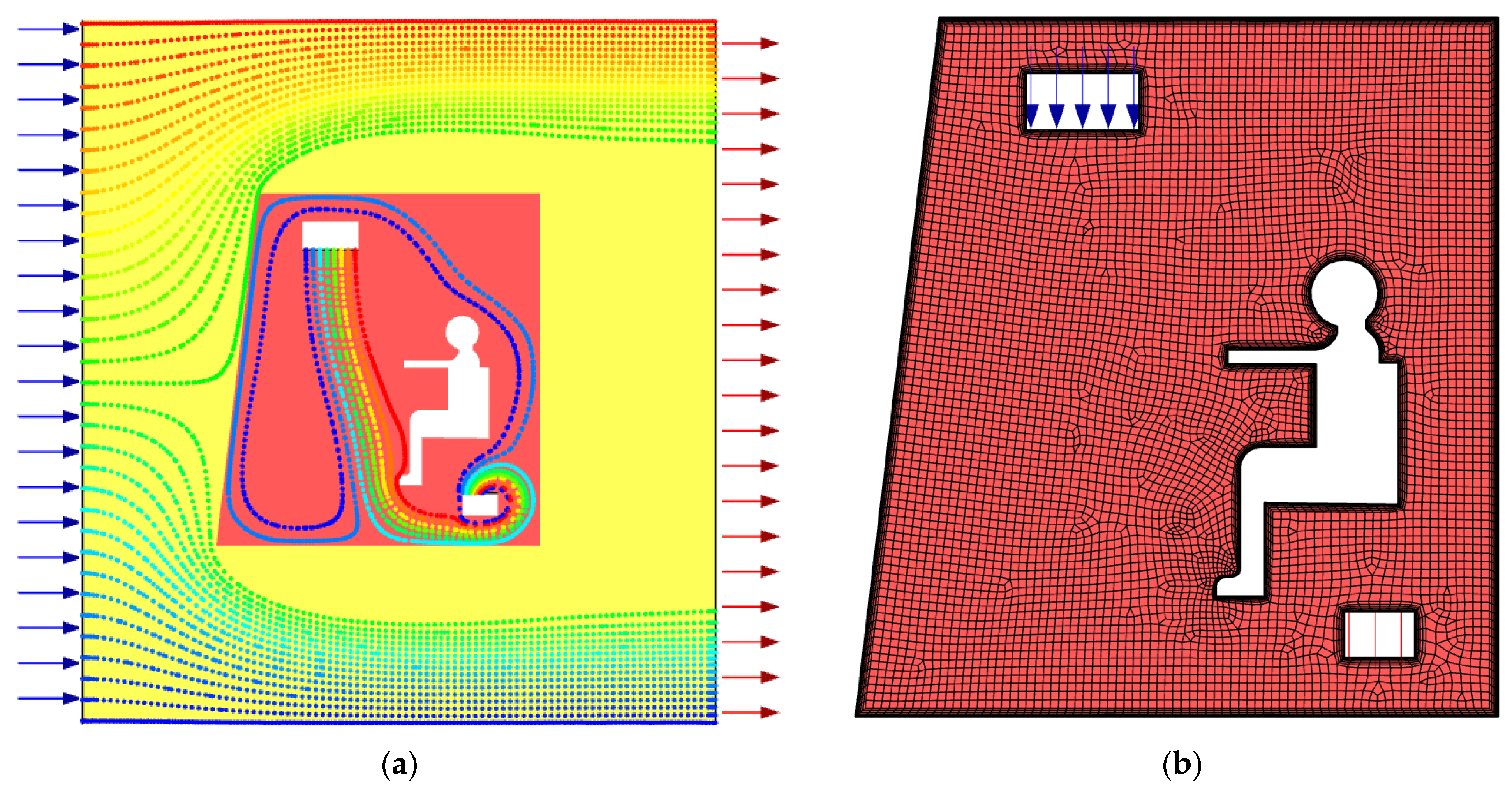
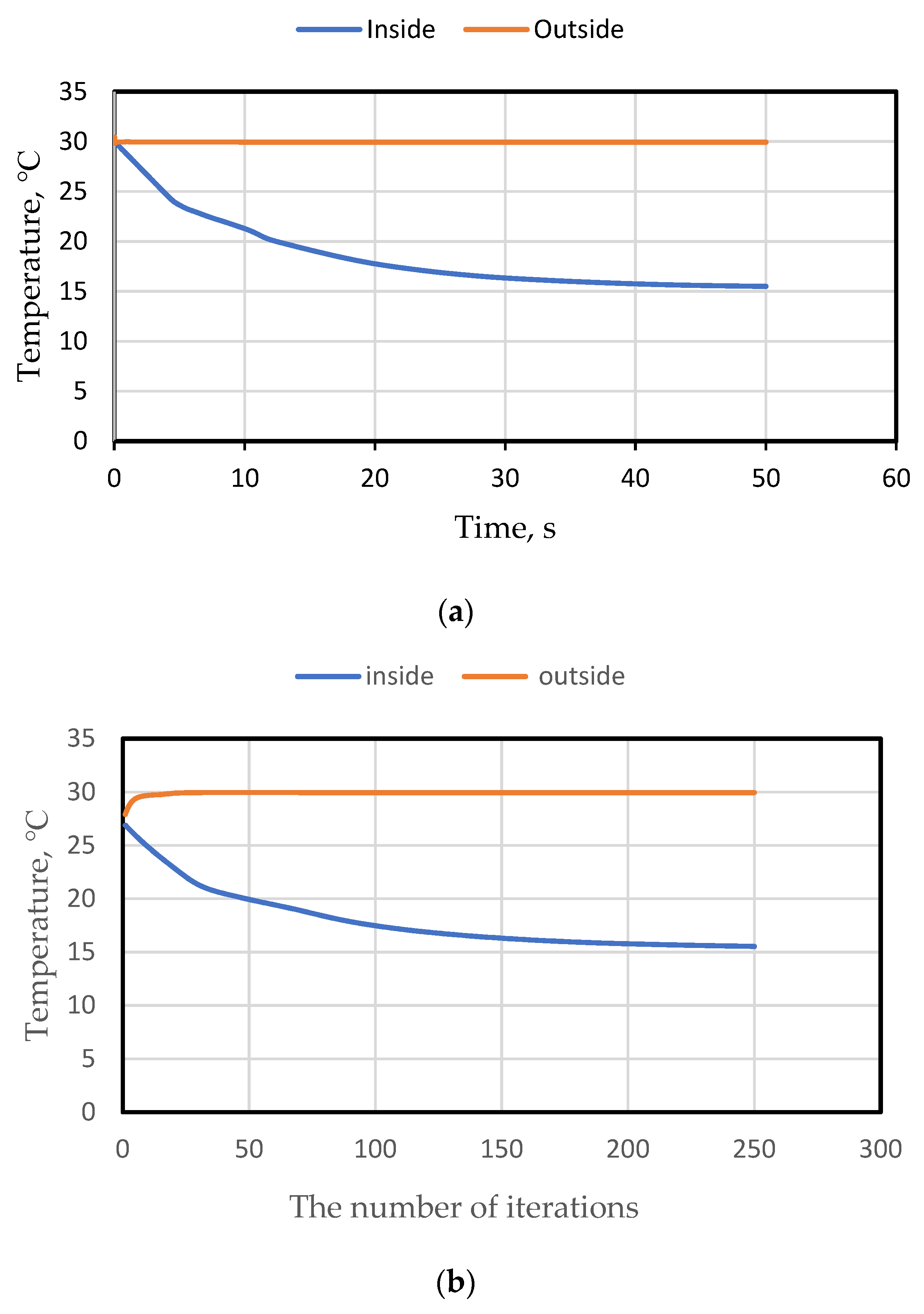


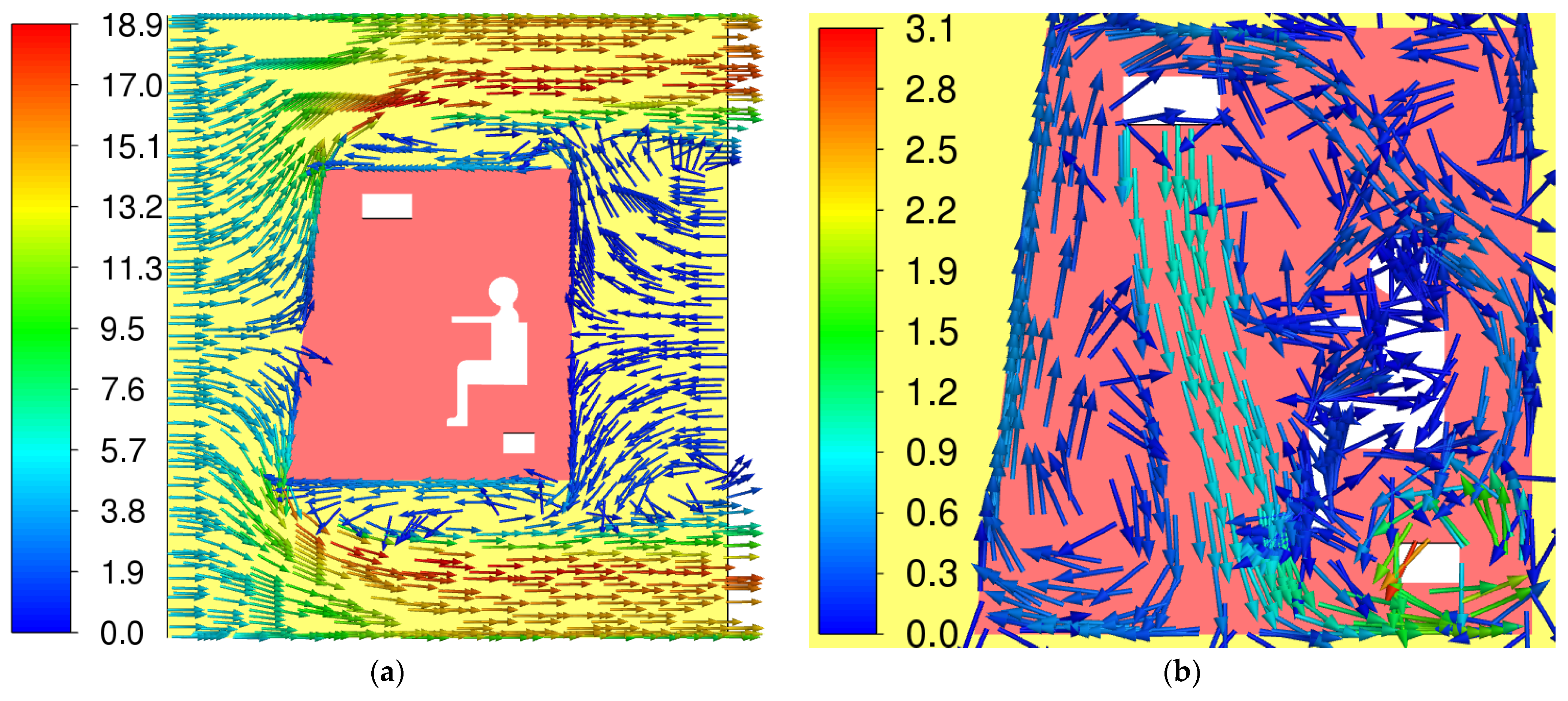


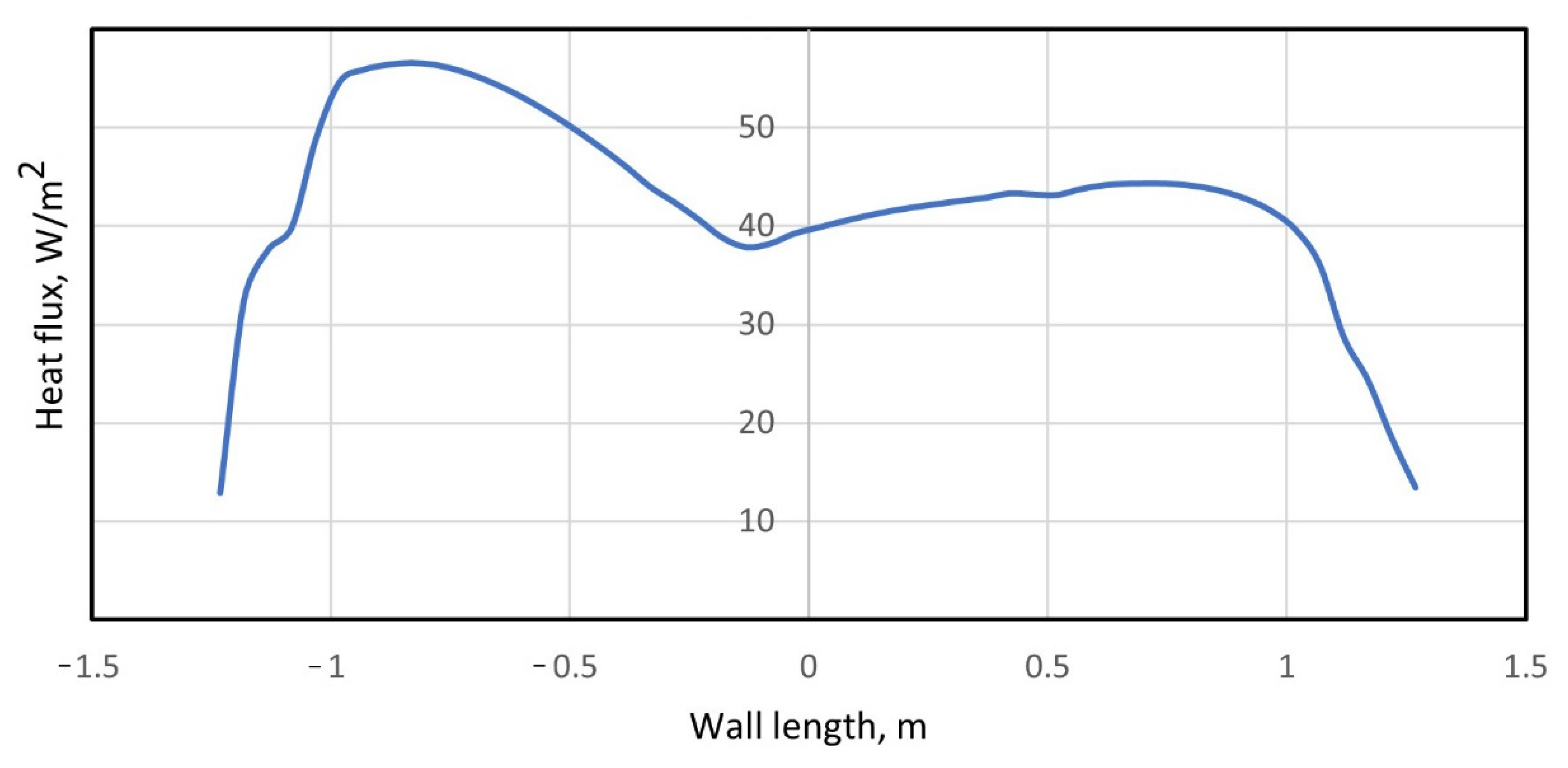






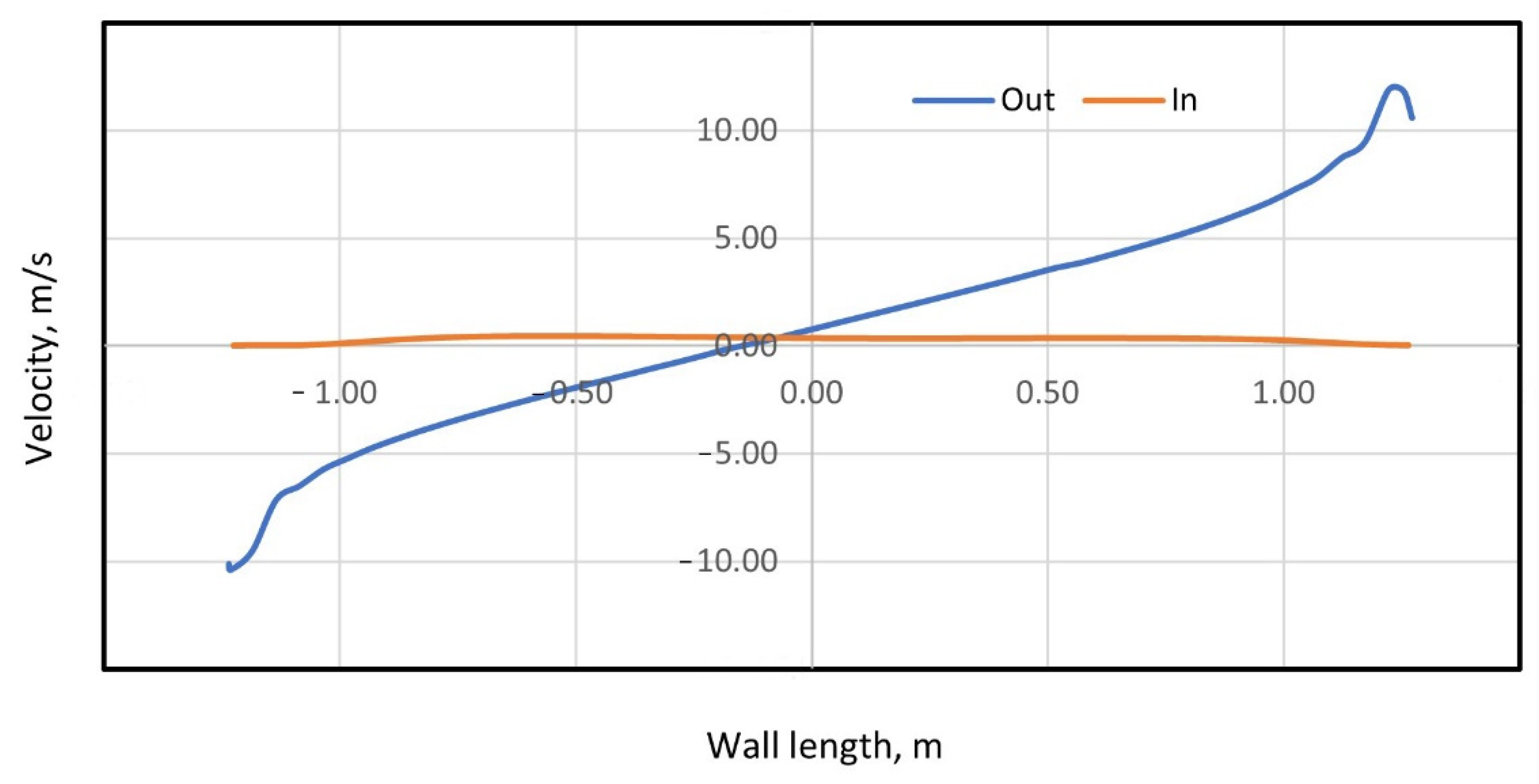

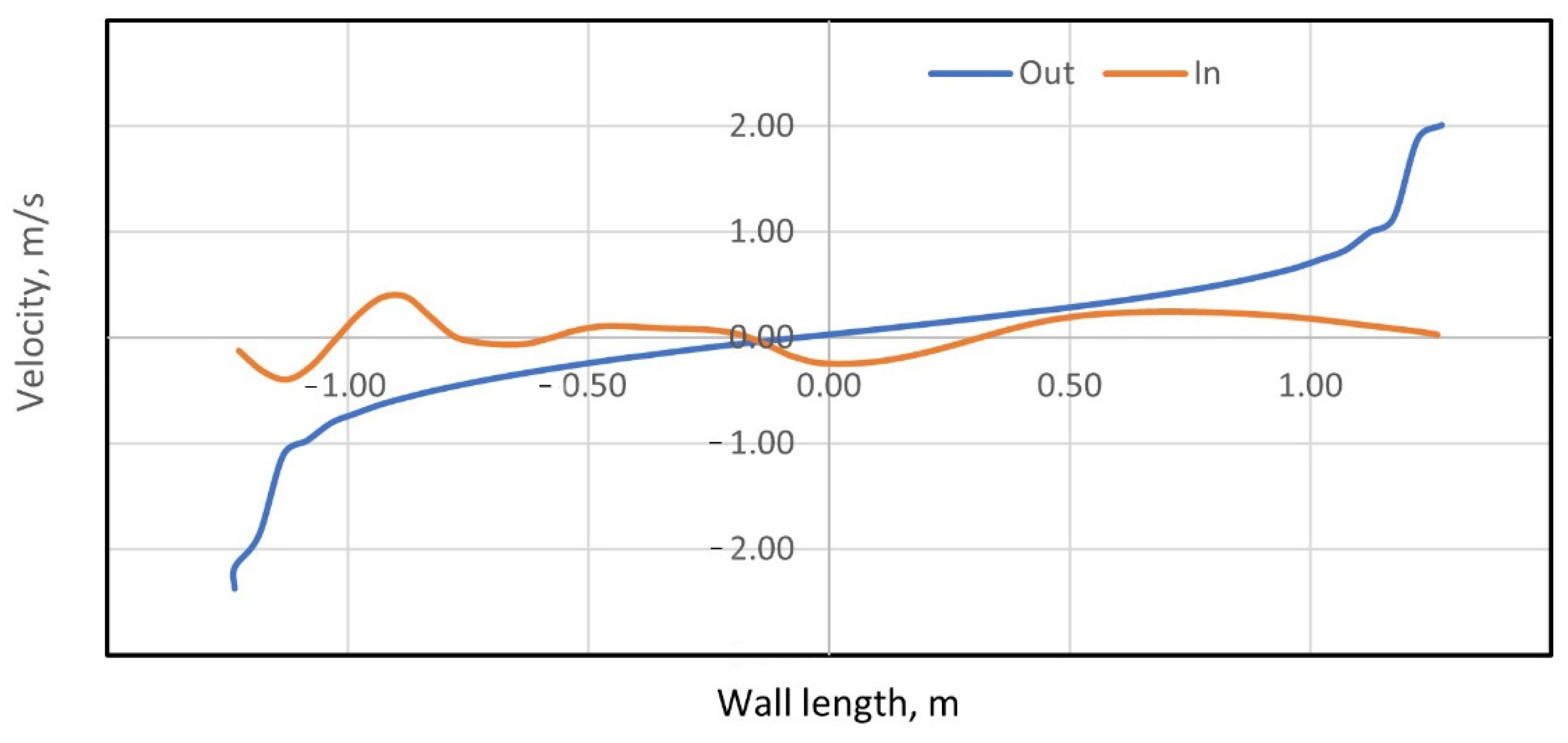

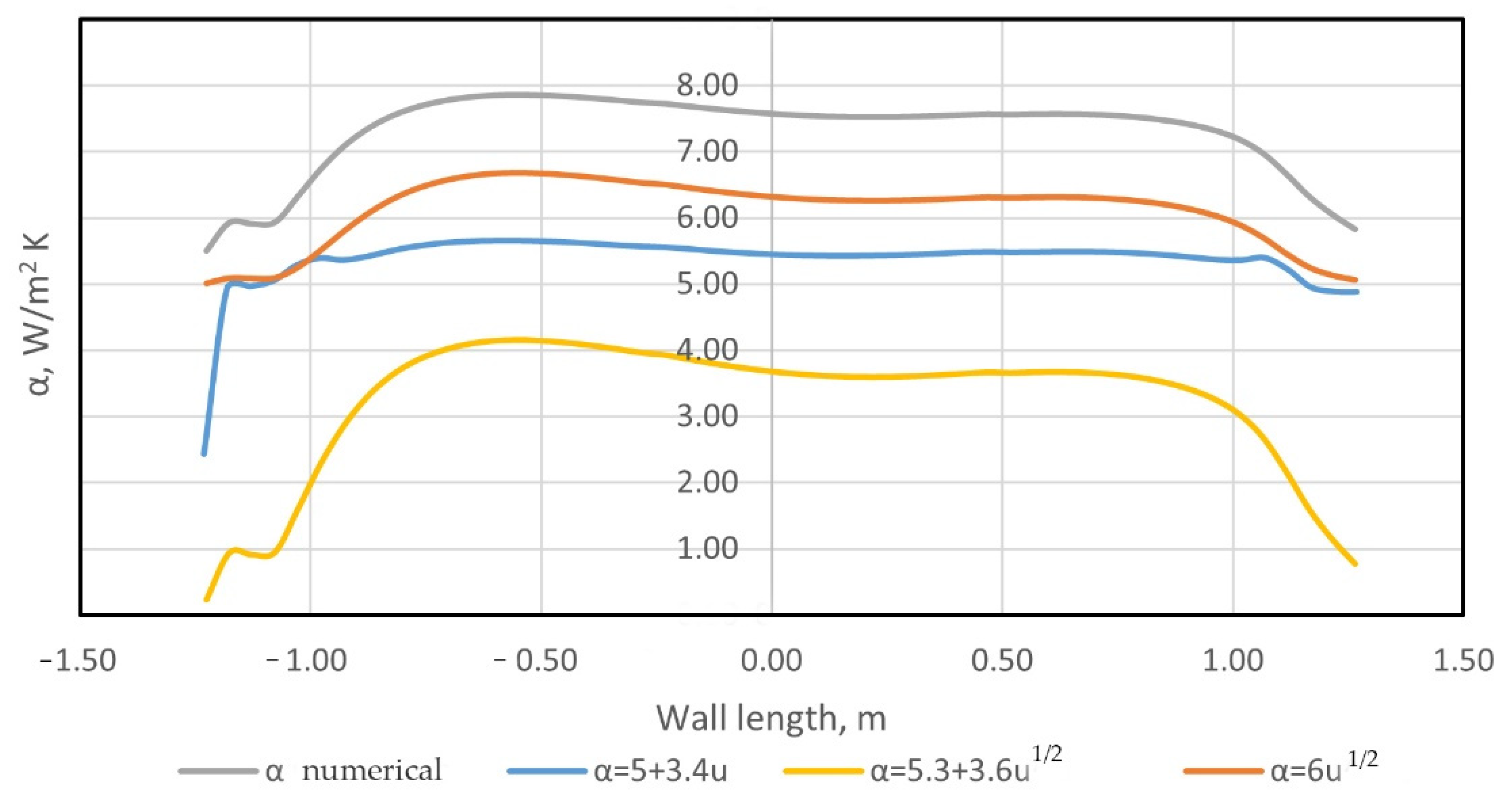
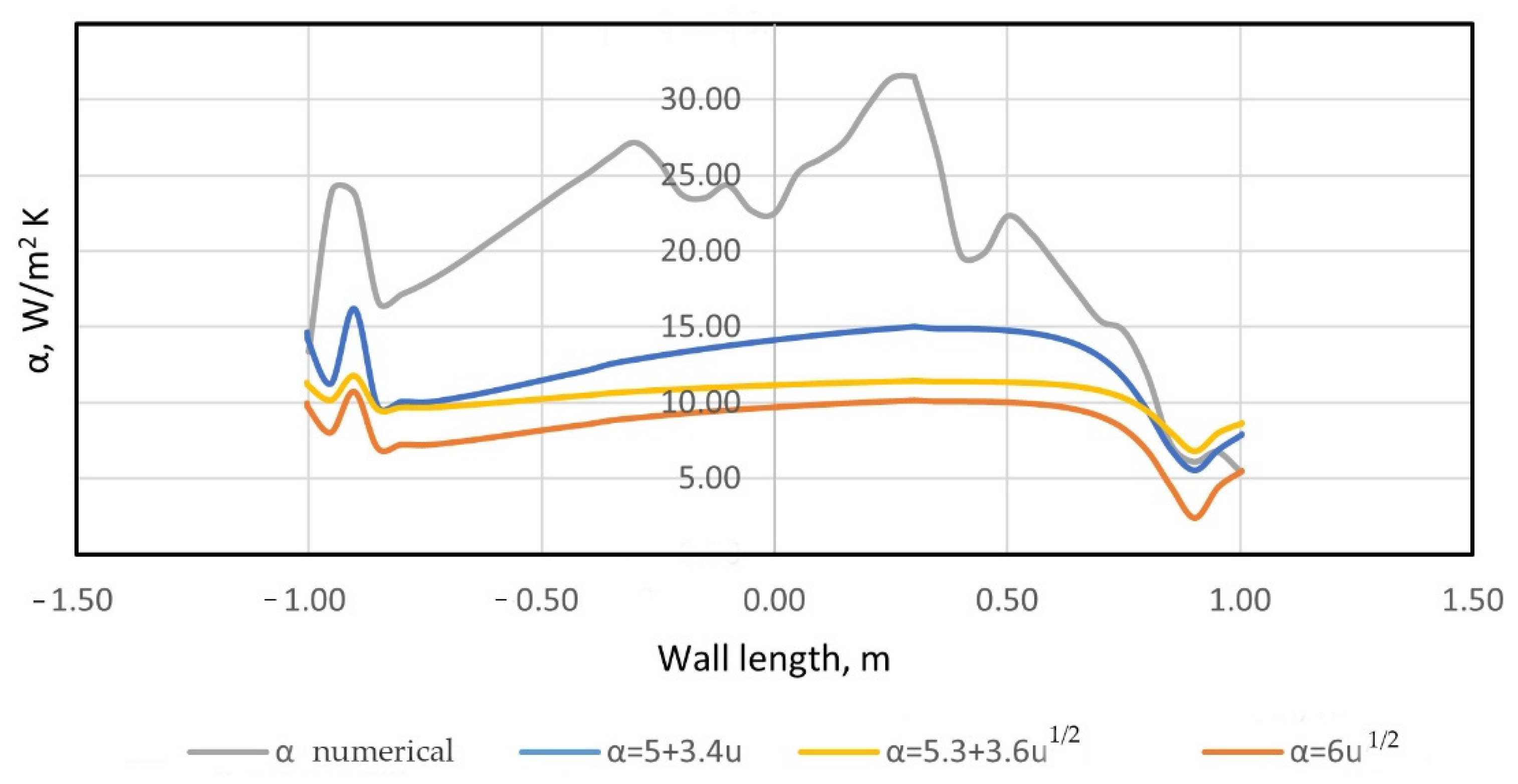
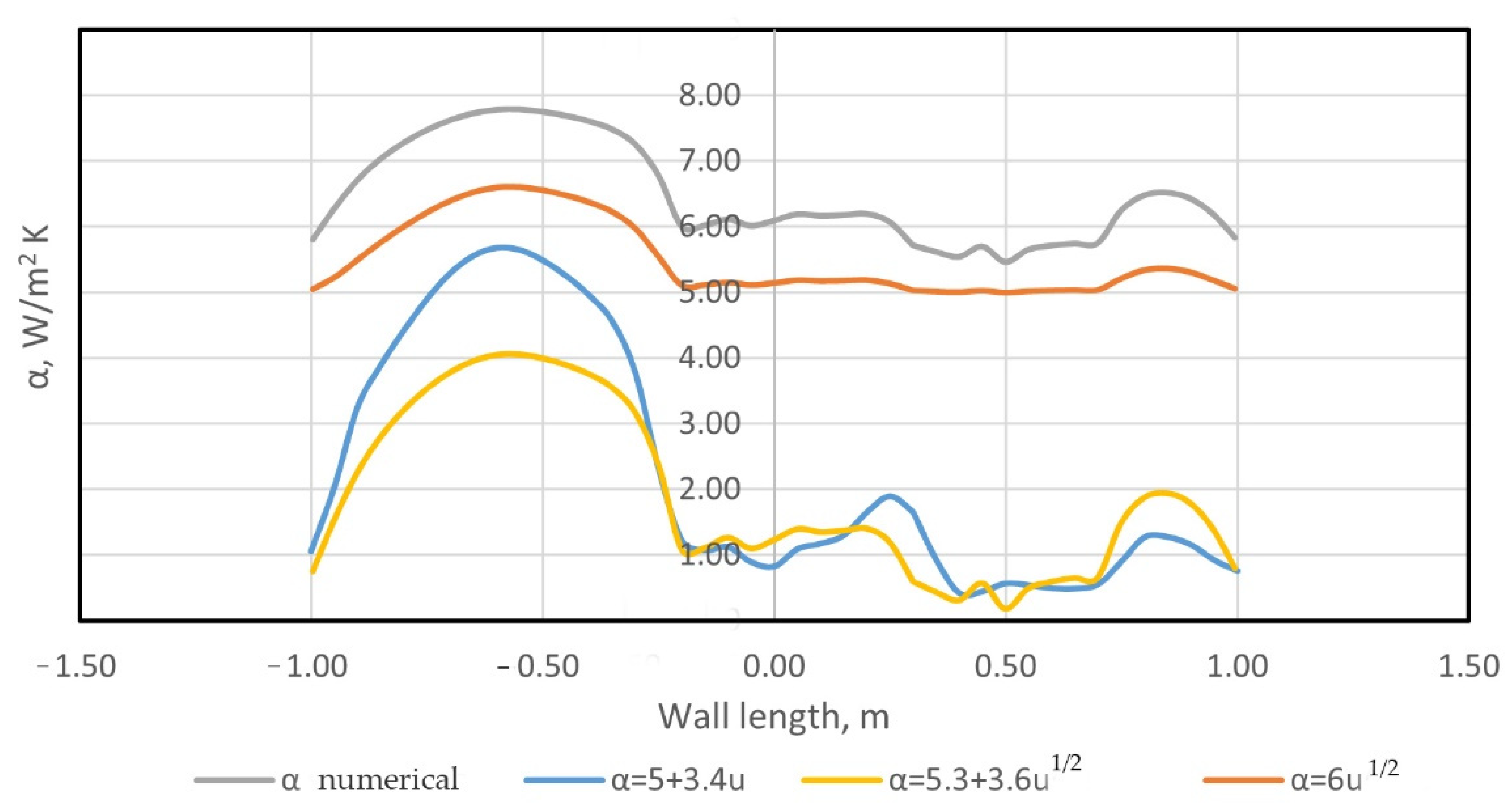
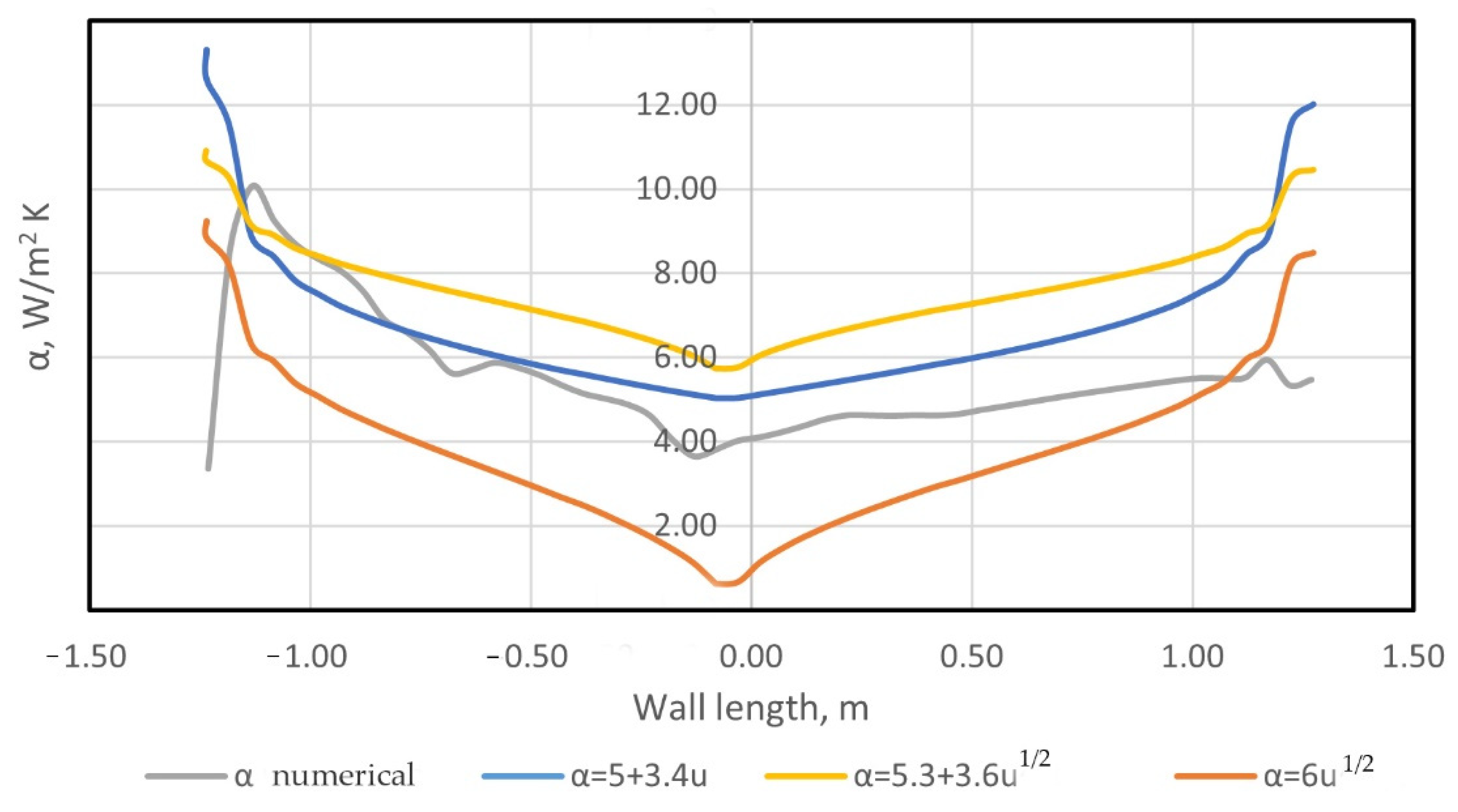
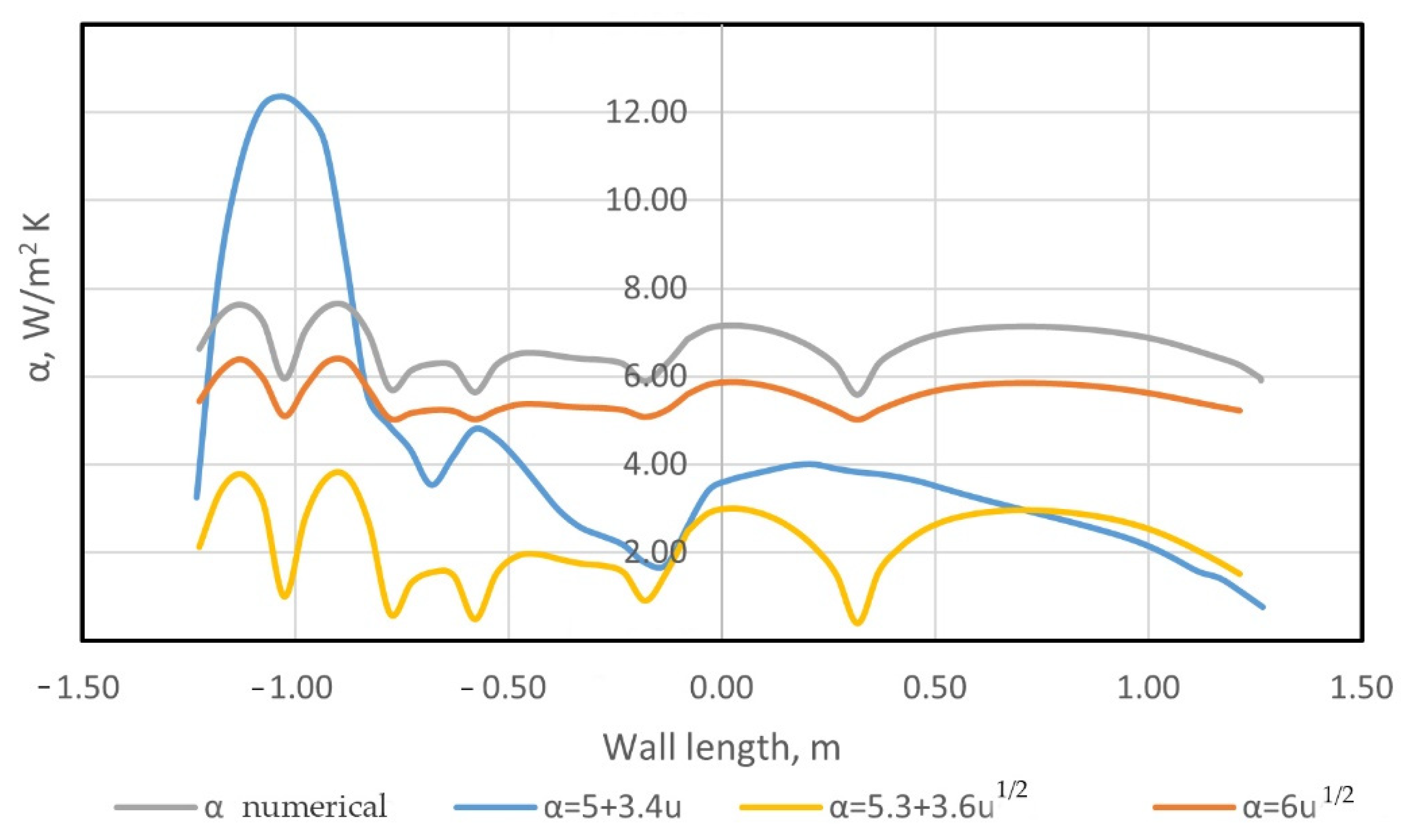
| Wall Material | Coefficient of Thermal Conductivity, | Thickness, m |
|---|---|---|
| Metal | 58 | 0.002 |
| Bituminous mastic layer | 0.27 | 0.0042 |
| Cast polyurethane | 0.32 | 0.025 |
| No. | Title | Value |
|---|---|---|
| 1 | Free stream speed, m/s | 5 |
| 2 | Incoming flow temperature, °C | 30 |
| 3 | Air flow rate in cabins, m/s | 1 |
| 4 | Cabin air flow temperature, °C | 14 |
| 5 | Thermal conductivity of air, W/(m2∙K) | 0.0242 |
| 6 | Heat capacity of air, J/(kg∙K) | 1006.43 |
| 7 | Average temperature on the human surface, °C | 25 |
| 8 | Molar mass of air, kg/mol | 28.966 |
| Wall | Coefficient Type | ||||
|---|---|---|---|---|---|
| Left wall | 5.3 | 5.7 | 6.9 | 2.7 | |
| 18.9 | 22.0 | 13.3 | 13.4 | ||
| Top wall | 2.3 | 5.7 | 6.9 | 2.7 | |
| 21.0 | 22.0 | 13.3 | 13.4 | ||
| Right wall | 4.3 | 5.7 | 6.9 | 2.7 | |
| 5.6 | 22.0 | 13.3 | 13.4 |
| Wall | Coefficient Type | ||||
|---|---|---|---|---|---|
| Left wall | 5.3 | 7 | 23 | 49 | |
| 18.9 | 14 | 29 | 29 | ||
| Top wall | 2.3 | 60 | 67 | 15 | |
| 21.0 | 5 | 36 | 36 | ||
| Right wall | 4.3 | 25 | 38 | 37 | |
| 5.6 | 75 | 58 | 58 |
Publisher’s Note: MDPI stays neutral with regard to jurisdictional claims in published maps and institutional affiliations. |
© 2022 by the authors. Licensee MDPI, Basel, Switzerland. This article is an open access article distributed under the terms and conditions of the Creative Commons Attribution (CC BY) license (https://creativecommons.org/licenses/by/4.0/).
Share and Cite
Beskopylny, A.N.; Panfilov, I.; Meskhi, B. Modeling of Flow Heat Transfer Processes and Aerodynamics in the Cabins of Vehicles. Fluids 2022, 7, 226. https://doi.org/10.3390/fluids7070226
Beskopylny AN, Panfilov I, Meskhi B. Modeling of Flow Heat Transfer Processes and Aerodynamics in the Cabins of Vehicles. Fluids. 2022; 7(7):226. https://doi.org/10.3390/fluids7070226
Chicago/Turabian StyleBeskopylny, Alexey N., Ivan Panfilov, and Besarion Meskhi. 2022. "Modeling of Flow Heat Transfer Processes and Aerodynamics in the Cabins of Vehicles" Fluids 7, no. 7: 226. https://doi.org/10.3390/fluids7070226







